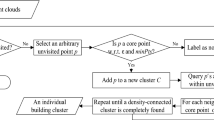Abstract
Clustering is an unsupervised learning method that provides insights by investigating unknown structures in a dataset without exploiting any ground truth target information. For constructing an as-built Building Information Models (BIM) from captured laser-scanned datasets, the segmentation process precedes modeling, which provides a baseline to be traced for obtaining 3D models from point clouds. For the segmentation process, a clustering algorithm can be effectively applied so that it can group the points having similar features without predefined criteria which, in turn, segments can be easily separated from the entire scene. Amongst various types of clustering algorithms, Hierarchical Density-Based Spatial Clustering of Applications with Noise (HDBSCAN) was developed as a density-based and hierarchical clustering algorithm which provides a simplified tree of significant clusters. This algorithm has several distinct advantages over other clustering algorithms: (1) avoids “flat” (i.e. non-hierarchical) labeling of data objects, (2) automatically simplifies the hierarchy into the most significant clusters, and (3) requires a single input parameter (i.e. minimum number of points) for density threshold. However, this algorithm has an overall computation time complexity represented as a quadratic form (i.e., \({\text{O}}\left( {dn^2 } \right)\)) which suffers from the computational efficiency issue especially for massive amounts of data such as those found in 3D point clouds. To ease the applicability of HDBSCAN to Scan-to-BIM applications, this research aims to parallelize major time-consuming components of HDBSCAN algorithm. OpenMP interface was adopted for thread parallelization and parallel efficiency was measured by calculating speedup and efficiency from strong and weak scaling results.
Access this chapter
Tax calculation will be finalised at checkout
Purchases are for personal use only
Similar content being viewed by others
References
Agapaki E, Nahangi M (2020) Scene understanding and model generation. In: Infrastructure Computer Vision, pp 65–167. Elsevier
Boruvka O (1926) "O jistém problému minimálním." Práce Mor. Prırodved. Spol. v Brne (Acta Societ. Scienc. Natur. Moravicae) 3(3): 37–58
F Bosché M Ahmed Y Turkan CT Haas R Haas 2015 The value of integrating Scan-to-BIM and Scan-vs-BIM techniques for construction monitoring using laser scanning and BIM: the case of cylindrical MEP components Autom Constr 49 201 213
Campello RJ, Kröger P, Sander J, Zimek A (2020) Density‐based clustering. Wiley Interdisc Rev: Data Min Knowl Discovery 10(2):e1343
Campello RJ, Moulavi D, Sander J (2013) Density-based clustering based on hierarchical density estimates. In: Proceedings of the 17th Pacific-Asia conference on knowledge discovery and data mining (PAKDD), pp 160–172
RJGB Campello D Moulavi A Zimek J Sander 2015 Hierarchical density estimates for data clustering, visualization, and outlier detection ACM Trans Knowl Discovery Data (TKDD) 10 1 1 51
T Cheng J Teizer 2014 Modeling tower crane operator visibility to minimize the risk of limited situational awareness J Comput Civ Eng 28 3 04014004
T Czerniawski B Sankaran M Nahangi C Haas F Leite 2018 6D DBSCAN-based segmentation of building point clouds for planar object classification Autom Constr 88 44 58
Ester M, Kriegel HP, Sander J, Xu X (1996) A density-based algorithm for discovering clusters in large spatial databases with noise. Kdd 96:226-231
V Estivill-Castro 2002 Why so many clustering algorithms: a position paper ACM SIGKDD Explor Newsl 4 1 65 75
Jung J, Stachniss C, Ju S, Heo J (2018) Automated 3D volumetric reconstruction of multiple-room building interiors for as-built BIM. Adv Eng Inform 38:811–825
JB Kruskal 1956 On the shortest spanning subtree of a graph and the traveling salesman problem Proc Am Math Soc 7 1 48 50
Ma JW, Czerniawski T, Leite F (2020) Semantic segmentation of point clouds of building interiors with deep learning: augmenting training datasets with synthetic BIM-based point clouds. Autom Constr 113:103144
RC Prim 1957 Shortest connection networks and some generalizations Bell Syst Tech J 36 6 1389 1401
Radenski A (2011) Shared memory, message passing, and hybrid merge sorts for standalone and clustered SMPs. In: 2011 International conference on parallel and distributed processing techniques and applications, vol 11, pp 367–373
Richter R, Döllner J (2010) Out-of-core real-time visualization of massive 3D point clouds. In: Proceedings of the 7th international conference on computer graphics, virtual reality, visualisation and interaction in Africa, pp 121–128
KH Rosen 2017 Handbook of discrete and combinatorial mathematics CRC Press
Shun J, Blelloch GE, Fineman GT, Gibbons PB (2013) Reducing contention through priority updates. In: Proceedings of the twenty-fifth annual ACM symposium on Parallelism in algorithms and architectures, pp 152–163
Q Wang M-K Kim JCP Cheng H Sohn 2016 Automated quality assessment of precast concrete elements with geometry irregularities using terrestrial laser scanning Autom Constr 68 170 182
Zhou W (2017) A practical scalable shared-memory parallel algorithm for computing minimum spanning trees. Master’s thesis, Karlsruher Institut für Technologie (KIT)
Acknowledgements
This research was supported, in part, by the National Science Foundation (NSF) under award number 1562438. Their support is gratefully acknowledged. Any opinions, findings and conclusions, or recommendations expressed in this material are those of the authors and do not necessarily reflect the views of the National Science Foundation. Mention of trade names in this article does not imply endorsement by the University of Texas at Austin or NSF.
Author information
Authors and Affiliations
Corresponding author
Editor information
Editors and Affiliations
Rights and permissions
Copyright information
© 2023 Canadian Society for Civil Engineering
About this paper
Cite this paper
Ma, J., Leite, F. (2023). Parallelization Strategies for Hierarchical Density-Based Clustering Algorithm Using OpenMP for Scan-To-BIM Applications. In: Walbridge, S., et al. Proceedings of the Canadian Society of Civil Engineering Annual Conference 2021. CSCE 2021. Lecture Notes in Civil Engineering, vol 247. Springer, Singapore. https://doi.org/10.1007/978-981-19-0968-9_43
Download citation
DOI: https://doi.org/10.1007/978-981-19-0968-9_43
Published:
Publisher Name: Springer, Singapore
Print ISBN: 978-981-19-0967-2
Online ISBN: 978-981-19-0968-9
eBook Packages: EngineeringEngineering (R0)




